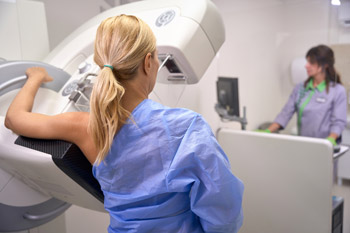Deets on Early Detection: A Woman's Guide to Cancer Screenings
by Emma Weisner
November 2024
In the hustle and bustle of everyday life, it's easy to let routine health checks slip by. After all, who wants to squeeze in a doctor's visit – especially for a cancer screening test that feels unnecessary? But the reality is that catching cancer early, before any symptoms appear, can be a game-changer.
Two early detection tests, called screening tests, are available for the cancers that take life from mothers, sisters, aunts, and grandmothers: screening tests for breast cancer and cervical cancers.
 Breast cancer is the
second leading cause of cancer death among women in the
U.S., and the most common cancer in Minnesota women
– about 5,000 are diagnosed every year. Most
people are familiar with the early test for breast
cancer, the mammogram, which is an X‑ray that can see
breast cancer before women or their doctors can even feel
it. Finding breast cancer early has benefits: more
treatment options to choose from and treatments with
fewer side effects. Maybe most important is that research
shows that early detection and early treatment allows 99%
of women to still be alive five years after breast cancer
diagnosis.
Breast cancer is the
second leading cause of cancer death among women in the
U.S., and the most common cancer in Minnesota women
– about 5,000 are diagnosed every year. Most
people are familiar with the early test for breast
cancer, the mammogram, which is an X‑ray that can see
breast cancer before women or their doctors can even feel
it. Finding breast cancer early has benefits: more
treatment options to choose from and treatments with
fewer side effects. Maybe most important is that research
shows that early detection and early treatment allows 99%
of women to still be alive five years after breast cancer
diagnosis.
According to the U.S. Preventive Services Task Force (USPSTF) guidelines, women aged 40 to 74 should get a mammogram every two years. However, other organizations recommend yearly screenings, particularly for women with a family history of breast cancer. Because age and screening frequency are influenced by so many factors, women can decide what's best for them after talking with their healthcare provider.
Cervical cancer is another cancer to keep on the radar. Although less common than breast cancer, it still impacts Minnesota women – about 3,200 currently have cervical cancer. This cancer develops at the opening of a woman's womb and is caused by the human papillomavirus (HPV). Unlike other viruses that are transmitted by blood and body fluids, HPV is a very common virus that is transmitted by skin-to-skin contact. There are several types of HPV. In addition to the one that causes warts on the hands and feet, another type is cancer-causing and can lead to cancer in areas of intimate skin-to-skin contact.
Something unique about the HPV virus is that a person's immune system will sometimes clear it from the body and prevent it from causing warts or cancer. Because there's not any test that allows doctors to predict if that will happen, prevention with a vaccine is an option to help avoid this cancer. Current science shows that women who get an HPV shot series during childhood have up to a 90% chance of preventing cervical cancer in the future. The shots work best if they're started before age 11, but in some circumstances adults up to age 45 might also be eligible for the vaccines.
Now, back to the topic of early detection. The screening test for cervical cancer is looking at cervical cells themselves and that comes with a Pap smear. Like breast cancer, there are usually no early signs of cervical cancer visible to the naked eye. A pap smear involves using a swab to swipe the cervix and grab a sample of cervical cells for a microscopic examination. The USPSTF recommends that women start getting Pap smears at age 21, with follow-up tests every three years until age 29. At 30, women can combine a Pap smear with an HPV test every five years. The HPV test is tagged on to the Pap smear and uses chemical reactions to look for the virus itself. Cancer researchers say that the combination of HPV vaccination and regular Pap smears with HPV testing can nearly eliminate the risk of cervical cancer in most women.
For women who are interested in early detection of breast and cervical cancer, mammograms, pap smears, HPV testing, and even vaccinations are steps to consider. To know the best time to get these done, discuss recommended age guidelines with a healthcare provider. Yes, it takes time to have breast and cervical cancer testing done, but by completing them regularly, cancers are more likely to be caught early when they're most treatable. Consider taking that step today and schedule a screening.
About the Author
 Emma Weisner is a third-year medical student at
the University of North Dakota School of Medicine &
Health Sciences. She was selected as the Ortonville
participant for the school's ROME program, or Rural
Opportunities in Medical Education, a program that
teaches student doctors how rural newspapers can be
partners for disseminating health information. As a
future rural healthcare leader, Weisner has written this
column for her ROME community. The information is not for
diagnosis or treatment and should not be used in place of
previous medical advice provided by a licensed provider.
Emma Weisner is a third-year medical student at
the University of North Dakota School of Medicine &
Health Sciences. She was selected as the Ortonville
participant for the school's ROME program, or Rural
Opportunities in Medical Education, a program that
teaches student doctors how rural newspapers can be
partners for disseminating health information. As a
future rural healthcare leader, Weisner has written this
column for her ROME community. The information is not for
diagnosis or treatment and should not be used in place of
previous medical advice provided by a licensed provider.
